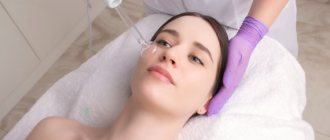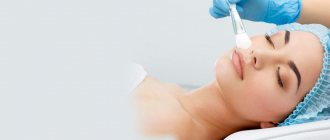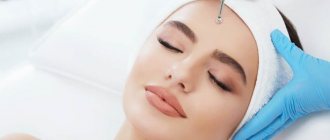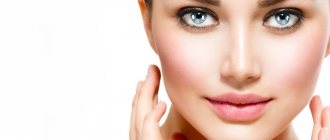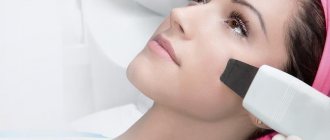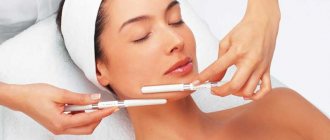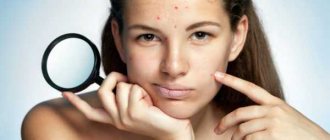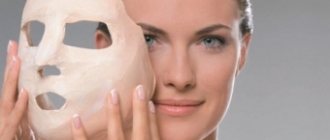The Center for Cosmetology and Medicine “Health” conducts combined facial cleansing on Elektrozavodskaya and Semenovskaya. The manipulation technology combines two types of cleaning – manual and ultrasonic. Despite the delicacy of the effect, the procedure is highly effective, so a beauty salon can safely recommend this technique.
The Health Clinic guarantees high effectiveness and safety of cosmetic procedures, since the qualifications of specialists are confirmed by medical education, courses and many years of experience in this industry. At the same time, the price for comprehensive facial cleansing corresponds to the quality, and its results will not leave you disappointed.
The essence of the procedure
Combined cleansing is a facial cleansing procedure that combines the principles of manual and ultrasonic cleansing. Manual cleansing, when performed as an independent method, has an aggressive effect on the skin, but in combination with the use of ultrasound, the procedure is safe. Complex facial cleansing is a series of gentle manipulations, but at the same time it is in great demand among clients due to its effectiveness.
Combined peeling is suitable for clients with hypersensitive skin or if the patient's skin requires special care. The procedure has virtually no contraindications and is used in cases where other types of cleansing are not recommended due to absolute contraindications. The session is painless and comfortable, eliminating the possibility of injury to the skin. An integrated approach includes the following implementation principle: the cosmetologist mechanically “cleanses” only excessively contaminated areas where there is an abundant amount of fatty deposits, comedones and deep blackheads. The remaining areas are subject to ultrasonic cleaning: the method ensures exfoliation of dead skin particles, eliminates pigmentation and helps eliminate swelling.
Description of the procedure
We recommend that mechanical cleaning be done exclusively in the clinic. There are several reasons for this. Firstly, a doctor first examines you, determines your skin type, degree of contamination, and only after that determines the appropriate type of cleansing. Each case is individual. Secondly, the cleaning is carried out by a certified specialist who knows all the nuances of working with leather. Thirdly, by doing manual facial cleansing in a clinic, you will be confident that hygiene standards will be observed. This way the procedure will be safe for your health. The number of procedures depends on the condition of your skin. If there is not a lot of contamination, then perhaps one session will be enough. But our experience shows that more often is required. Don't try to cleanse your entire face in one session. Not only will this not give the desired effect, but it may also be ineffective. Large tissue swelling may occur, which will interfere with the functioning of the sebaceous glands. Following this, the pores will become clogged even more, which will lead to the appearance of new comedones.
Therefore, we do not recommend doing manual facial cleansing too often. In addition, this is a rather aggressive procedure. Each skin type will have its own interval. For some, one procedure every six months will be enough, while others will need to visit a cosmetologist every 1-2 months. The main thing is that you get in the end: smooth skin texture, narrowed pores, no dirt or inflammation, improved blood circulation and complexion, pores breathe freely.
Contraindications
Combined facial skin cleansing is not performed in the following cases:
- in the presence of skin diseases (dermatitis, eczema, psoriasis, rosacea);
- with herpes;
- with demodicosis;
- with rosacea (vascular networks);
- in the presence of acute inflammatory processes of the skin;
- with increased dryness of the skin;
- with a tendency to allergies;
- in the presence of large protruding moles in the affected areas;
- in case of violations of the integrity of the skin and mechanical damage;
- for cardiovascular diseases;
- in the presence of formations of any etiology (benign and malignant);
- during pregnancy;
- when performing other cosmetological procedures in parallel (to be discussed individually with a cosmetologist).
ATRAUMATIC CLEANING
The very name “atraumatic” indicates that the skin is not injured during the facial procedure. During cleansing, special multi-phase cosmetics are used that dissolve comedones and sebaceous plugs, exfoliate cells and cleanse the skin, reduce redness and rashes.
Indications
This method is indicated for people whose capillaries are located very close to the surface of the skin and can burst due to mechanical cleaning. There are also situations where atraumatic cleansing will help solve many dermatological problems. It is indicated to solve the following problems:
- acne;
- rosacea;
- acne;
- black dots;
- scars after acne or pimples;
- small wrinkles;
- severe dry skin;
- closed comedones.
Before carrying out atraumatic cleansing, you must visit a dermatologist and find out if you have any contraindications. In addition, it is worth remembering that atraumatic cleaning cannot be carried out in ordinary beauty salons; it is done only by qualified specialists in medical centers.
Contraindications
This point should be paid special attention to people prone to allergies to various cosmetics, as well as those with various skin diseases. Atraumatic cleaning is contraindicated:
- people with dermatitis;
- for allergy sufferers;
- children under 16 years of age;
- people with eczema;
- people with burns or fresh wounds on the skin.
Action
The delicacy of the technique does not in any way reduce the intensity of the final result. After the first session, the patient will be able to notice characteristic changes in facial skin for the better, namely:
- elimination of impurities and stratum corneum;
- opening of the sebaceous glands;
- activation of metabolic processes and improvement of local blood circulation;
- disappearance of comedones, blackheads, pimples and shallow wrinkles;
- elimination of swelling and compaction;
- noticeable smoothing of skin texture;
- eliminating the lethargic appearance;
- visual reduction of scars and scars.
Indications for facial cleansing
The procedure is recommended to be carried out regularly for any skin type. The frequency is determined by the cosmetologist after the examination. Reasons for more frequent cleaning may include:
- Increased secretion of sebaceous glands, oily sheen.
- Enlarged pores.
- Blackheads, acne, comedones.
- Peeling, presence of stratum corneum.
- Disturbance of complexion, appearance of pigment spots.
- Formation of facial wrinkles.
- Violation of skin relief.
Facial cleansing in the salon is also carried out for detoxification, as the procedure helps remove toxins and reduce the negative impact of external factors on the skin.
Stages of combined cleaning
- Preparation. 10 days before the scheduled manipulation, you should exclude visits to the solarium and sauna, and also avoid visiting the beach for a while, as the skin becomes vulnerable as a result of the influence of ultraviolet rays. Compliance with this rule will protect the patient from the possibility of burns and injury during the procedure. In addition, it is recommended to temporarily remove allergenic foods from the diet, as well as dishes that cause dehydration.
- Skin preparation. Immediately before cleaning, the cosmetologist removes makeup using a special product in accordance with the patient’s skin type.
- Scrubbing. This stage is carried out if necessary (decided by the cosmetologist). Using a scrub with circular massaging action helps remove surface impurities. Thanks to this, the pores open wide, which increases the effectiveness of the procedure.
- Face massage. Performing a light massage is carried out to relax the muscles and relieve tension. Massage actions increase the susceptibility of the skin layers to distant manipulation.
- Steaming. To better eliminate facial skin defects in the form of wen, sebaceous plugs, comedones, etc., the skin must be treated with a warm steam jet. The steam exposure procedure lasts for 3-5 minutes. If there are contraindications to steam steaming, cold hydrogenation is carried out. In this case, a thermal heating gel is applied to the face, the effect of which is aimed at opening the pores and loosening “dead” cells. Cover the applied product with a film, then wait 15-20 minutes, then proceed to the next stage.
- Antiseptic treatment. The cosmetologist treats the selected areas of exposure with an alcohol-based lotion or other product with a disinfectant effect.
- Mechanical technique. The specialist performs a mechanical cleaning element, with the help of which deep defects are eliminated, which cannot be achieved by using ultrasound. Cleaning is carried out selectively - in places of particular contamination. Typically, during mechanical cleaning, a special tool is used, for example, a Uno spoon, etc. However, in some cases, manual cleaning is necessary. The average duration of the process is 5-7 minutes.
- Ultrasonic cleaning. This stage is the main one during combined facial cleansing. The specialist applies a gel base, which is necessary for better transmission of ultrasonic waves into the layers of the epidermis, and moves a special emitter in the shape of a spatula over the skin. During the procedure, the skin is regularly moisturized with a soothing effect. In some salons, ultrasound technology can be replaced by laser technology, which is also highly effective.
- The final stage. To rehabilitate the skin after cleaning, repeated disinfection is provided to avoid infection and inflammation. Then masks of a special composition containing cosmetic clay and other natural ingredients are applied. The very last stage is the application of a moisturizing and nourishing composition.
How is the procedure performed?
First, you need to prepare your skin - wash off your makeup and cleanse it of surface impurities with products that are suitable for your skin type.
Then the face is steamed with hot compresses or masks. At this stage, the pores expand and the surface layer of the skin softens. This will help the specialist make cleaning as atraumatic as possible.
The cosmetologist works with each inflammation separately and manually. Despite careful preparation before this stage, painful sensations cannot be avoided. If you have a low pain threshold, you should immediately tell a specialist about it.
A special uno spoon can be used as a tool. At one end it has a ring, with the help of which the cosmetologist cleans the pores. The surface of the ring is smooth, so it will not scratch your skin. All instruments must be sterilized before the procedure.
The next step is to apply a soothing mask or serum. After the procedure, you need to soothe the skin, reduce irritation and redness, and narrow the pores.
Finally, a protective cream is applied.
There will be some swelling after the procedure. This is a normal reaction.
How long does the procedure take?
Approximately, facial cleansing takes 60-90 minutes. The session time depends on the area of the treatment area. Also keep in mind that if you are coming for the procedure for the first time, a consultation before it will be mandatory.
Skin care after cleansing
Combined facial cleansing by a cosmetologist includes rehabilitation skin care at the end of the session, however, at home you must also follow a number of recommendations:
- For the first 7-10 days after cleaning, it is necessary to avoid exposure to high temperatures and ultraviolet rays.
- Apply soothing products that contain aloe vera, chamomile and calendula extract.
- Apply disinfectants to your facial skin.
- For redness, apply medicinal restorative ointment (Bepanten, Panestin).
Post-procedure care
After the atraumatic cleansing procedure, special care is required. Firstly, you should not apply any cosmetics for two to three days after the procedure, because if it gets into clean pores, they may become clogged and a rash will appear.
Secondly, during the week you cannot visit the solarium, swim in pools, or be in the open sun or wind. The skin after peeling is very delicate and susceptible to external influences, so it can easily become dry and damaged.
Thirdly, after cleansing, you need to cleanse your face with special preparations, which the specialist who performed the procedure will tell you about. They will help avoid infectious inflammation and pore contamination.
Atraumatic facial cleansing is done once every 3-4 months, after which the effect lasts quite a long time, because... fruit acids normalize sebaceous metabolism in the skin, and it becomes less dirty.
Mechanical cleaning - how often can sessions be carried out?
The desire to get rid of problem skin raises many questions: is it necessary and how often can mechanical facial cleansing be done? Many cosmetologists speak about the effectiveness and the main task that is set when performing this procedure - to get rid of acne, acne and the notorious blackheads that spoil any image. However, the method does not always bring the expected results; the main reason for this is the use of the same methods and products to cleanse the skin of all patients. At the Mediostar cosmetology clinic, they will first of all help you determine the condition of your skin, only then will they carry out high-quality cleaning using individually selected products and indicate when to repeat the session.
Before carrying out the procedure, familiarize yourself with its features:
- manual removal of impurities and correction of imperfections involves stretching the skin;
- During the procedure, peelings, cold hydrogenation or its analogues are used;
- attention and an individual approach to removing each type of contamination can minimize risks and improve the result, but still such cleaning is quite aggressive.
Mechanical or manual cleaning in a salon cannot eliminate the cause of the appearance of new rashes, but it effectively combats already visible imperfections. With each subsequent procedure, fewer and fewer manifestations of problematic skin will remain on the face. The frequency of the procedure is determined primarily by the general condition of the skin, because in advanced cases, a professional cosmetologist cannot remove all comedones and blackheads in one session, damaging the skin. The specialist will not touch inflamed and immature pimples, so as not to increase the risk of developing an infection.
Interview with a doctor about facial cleansing
— Cleaning can be manual or machine. Both, if a guaranteed positive result is needed, are carried out in cosmetology clinics using special equipment and only by dermatovenerologists. When using hardware cleaning, the skin is exposed to ultrasound or galvanic current. Typically, cosmetologists use a combined procedure, combining manual and hardware techniques. Before performing facial cleansing, a dermatovenerologist identifies the presence of contraindications. Most often, the procedure is not performed if there are large areas of inflammation on the face. With such indications, there is a high risk of infection in open wounds after the procedure. Peels are a gentle alternative to facial cleansing. Today, a large number of different peelings are used, which use different acids. Such a wide range allows you to choose the appropriate composition for a particular skin type.
The presence of different acids in the composition allows you to achieve certain results:
- milk moisturizes the skin;
- salicylic and Jesner peels eliminate inflammation and dry the skin;
- Almond can be used year-round for all skin types, helping to reduce pores and combat hyperpigmentation.
All types of peelings make the skin smoother and fresher. Cosmetologists recommend that all women who have previously used a cleansing procedure switch to peelings, choosing the optimal composition for themselves. To get the maximum effect, you need to carry out this procedure in courses. Depending on the skin type, the skin is treated 2 to 6 times. With the correct selection of peeling and adherence to the technique, the procedure will bring maximum effect. To care for problem skin, you need to use an integrated approach. In addition to proper cleaning, you will need to avoid cosmetics that cause comedones. This will help your skin stay fresh and free of blackheads for a long time after cleansing. You should also lead a healthy lifestyle, get enough sleep regularly and choose a balanced menu. If this condition is met, in most cases the leather will not require cleaning. You should also consider your skin type when choosing a peel.
- Women with dry skin should avoid facial cleansing and peeling procedures.
- For combination and oily skin, you need to use a set of cleansing, moisturizing and nourishing procedures, as well as monitor your diet and rest regularly. You also need to combine home and salon treatments to get the maximum effect from cleansing and peeling.

